Special Service Tools Required:
| Description | Tool Number |
| Syncro Positioning Tool – 3.0L, 4.0L | T95T-12200-A |
| Syncro Positioning Tool – 5.0L | T96T-12200-A |
CAUTION: Syncro Positioning Tool T95T-12200-A (3.0L, 4.0L) or T96T-12200-A (5.0L) must be obtained prior to installation of the replacement synchronizer assembly. Failure to follow this procedure will result in the fuel system being out of time with the engine (6007), possibly causing engine damage.
CAUTION: Prior to the removal of the camshaft position sensor (CMP sensor) (12A112), set No. 1 cylinder to 0 degrees top dead center (TDC) of compression stroke. Then note the position of the camshaft position sensor electrical connector. The installation procedure requires that the electrical connector be located in the same position.
Removal:
1. Disconnect battery ground cable (14301).
2. Disconnect fuel charging wiring electrical connector from camshaft position sensor.
3. Remove the CMP sensor screws and camshaft position sensor from camshaft synchronizer.
CAUTION: Do not move crankshaft (6303) until entire installation procedure is complete. Doing so will result in the fuel system being out of time with the engine resulting in possible emissions fault.
NOTE: If camshaft synchronizer is to be removed from the cylinder block (6010), proceed with Step 4. If the camshaft synchronizer is not being removed, proceed to installation Step 8.
4. Remove hold-down clamp (12270).
5. Remove camshaft synchronizer from cylinder block.
Installation:
1. Attach Syncro Positioning Tool T95T-12200-A (3.0L, 4.0L) or T96T-12200-A (5.0L).
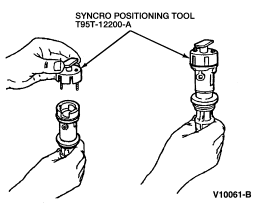
Camshaft Synchronizer – 3.0L, 4.0L
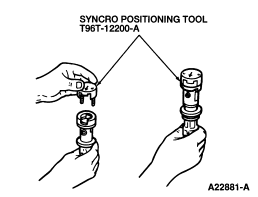
Camshaft Synchronizer – 5.0L
2. Align the synchronizer vane with the radial slot of the Syncro Positioning Tool T95T-12200-A (3.0L) or T96T-12200A (5.0L).
3. Rotate the tool on the synchronizer base until the tool’s boss engages the base notch.
4. Dip gear end into ESE-M2C123-A oil or equivalent to coat gear, thrust washer and lower bearing.
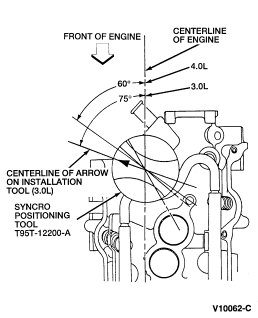
Syncro Positioning Tool – 3.0L, 4.0L
5. CAUTION: Do not rotate crankshaft when syncro positioning tool is on the camshaft synchronizer. Armature tab will be damaged and synchronizer timing may be shifted.
On 3.0L engines, install camshaft synchronizer so that drive gear engagement occurs when arrow on Syncro Positioning Tool T95T-12200-A is pointed approximately 75 degrees (3.0L), 60 degrees (4.0L) counterclockwise off the centerline of the engine. This step will locate camshaft position sensor electrical connector to the original position.
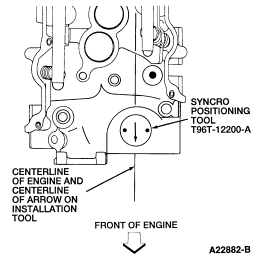
Syncro Positioning Tool – 5.0L
On 5.0L engines, install camshaft synchronizer into cylinder block making sure that arrow on Syncro Positioning Tool T96T-12200-A is pointing forward parallel to center line of crankshaft. This step will locate camshaft position sensor electrical connector to the pre-removal position.
6. CAUTION: If camshaft position sensor electrical connector is not positioned properly, DO NOT reposition the connector by rotating the synchronizer assembly. This will result in the fuel system being out of time with the engine, possibly causing engine damage. Remove the synchronizer assembly and repeat Step 5.
Install hold-down clamp and tighten to 19-30 Nm (14-22 lb-ft) on 3.0L, 4.0L and 23-34 Nm (17-25 lb-ft) on 5.0L.
7. Remove Syncro Positioning Tool.
8. Install CMP sensor and CMP sensor screws. Tighten to 2.5-3.5 Nm (23-30 lb-in).
9. Connect fuel charging wiring electrical connector to camshaft position sensor (CMP sensor).
10. NOTE: When battery voltage is removed from the powertrain control module (PCM) (12A650), all learned values will be cleared and reset to predetermined values. When battery voltage is restored to the PCM, the vehicle may exhibit certain driveability concerns. It will be necessary to drive the vehicle to allow the PCM to relearn values for optimum driveability and performance.
Connect battery ground cable.
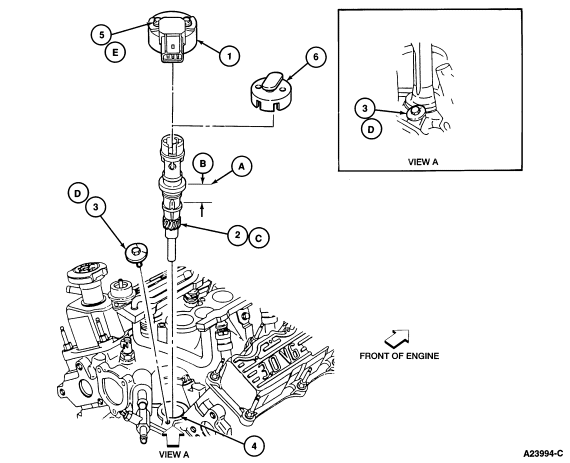
Camshaft Position (CMP) Sensor – 3.0L Shown, 4.0L, 5.0L Similar
| Item | Part Number | Description | |||
| 1 | 12A112 | Camshaft Position Sensor | |||
| 2 | 12A362 | Camshaft Synchronizer | |||
| 3 | 12270 | Hold-Down Clamp | |||
| 4 | 6010 | Cylinder Block | |||
| 5 | N602704-S | CMP Sensor Screws (2 Req’d) | |||
| 6 | T95T-12200-A | Syncro Positioning Tool (3.0L) (4.0L) | |||
| 6 | T96T-12200-A | Syncro Positioning Tool (5.0L) | |||
| A | – | Bottom of Flange | |||
| B | – | 22mm (.88 In.) Maximum | |||
| C | – | Pre-Lube Synchronizer Gear with ESE-M2C123-A Oil | |||
| D | – |
|
|||
| E | – | Tighten to 2.5-3.5 Nm (23-30 Lb-In) |
Also check out our:
And these other Camshaft Position Sensor pages
Ford Ranger 3.0L Camshaft Position Sensor / Synchronizer
About The Author:
Jim Oaks is the founder of TheRangerStation.com, the longest-running Ford Ranger resource online since 1999. With over 25 years of hands-on experience building and modifying Ford Rangers — including magazine-featured builds like Project Transformer — Jim has become one of the most trusted authorities in the Ford Ranger off-road and enthusiast space. In 2019, he was loaned a Ranger FX4 by Ford Motor Company to test and document across the TransAmerica Trail. Jim continues to inspire and guide Ranger owners around the world.
